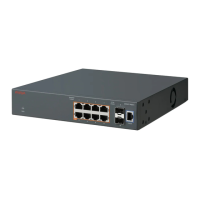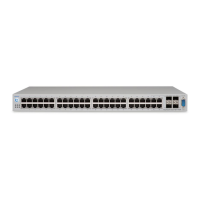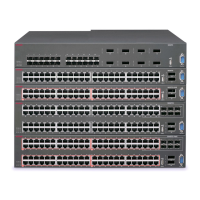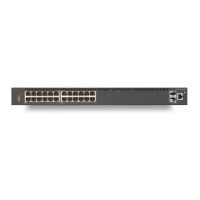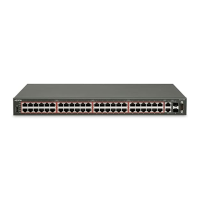Do you have a question about the Avaya ERS 3549GTS-PWR+ and is the answer not in the manual?
Explanation of Avaya Command Line Interface (ACLI) commands and modes.
Step-by-step guide for initial switch configuration via ACLI.
Details on stacking support and rear port functions.
Feature enabling replacement of a stack unit while retaining configuration.
Explanation of the CFG mirror image and its role in AUR.
Reducing power consumption without impacting connectivity.
Steps to connect a terminal to the console port.
Procedure to set IP address and subnet mask for the switch.
Enabling remote access via Telnet for switch management.
Configuring Telnet connection for switch management.
Testing network connectivity using the ping command.
General section for ACLI configuration.
Resetting the switch to its factory default configuration.
Managing switch configuration via files.
Configuring switch parameters for Converged IP Telephony solutions.
Enabling or disabling a port using ACLI.
Configuring power parameters for ERS 3500-PWR+ switches.
Setting the method to detect power devices connected to front ports.
Setting the PoE operating mode to low or high power budget.
Downloading and upgrading switch software images.
Upgrading both switch software and diagnostic images.
Safely shutting down a switch without corrupting software.
Safeguarding against configuration errors during remote changes.
General section for EDM switch configuration.
Configuring Quick Start setup via a single screen in EDM.
Configuring remote access settings for a switch in EDM.
Configuring IP Office solutions using EDM run scripts.
Displaying and managing Power over Ethernet (PoE) for a switch unit.
Setting the PoE power budget mode for the switch.
Example of setting up VLANs for voice and data traffic.
Explanation of Avaya Command Line Interface (ACLI) commands and modes.
Step-by-step guide for initial switch configuration via ACLI.
Details on stacking support and rear port functions.
Feature enabling replacement of a stack unit while retaining configuration.
Explanation of the CFG mirror image and its role in AUR.
Reducing power consumption without impacting connectivity.
Steps to connect a terminal to the console port.
Procedure to set IP address and subnet mask for the switch.
Enabling remote access via Telnet for switch management.
Configuring Telnet connection for switch management.
Testing network connectivity using the ping command.
General section for ACLI configuration.
Resetting the switch to its factory default configuration.
Managing switch configuration via files.
Configuring switch parameters for Converged IP Telephony solutions.
Enabling or disabling a port using ACLI.
Configuring power parameters for ERS 3500-PWR+ switches.
Setting the method to detect power devices connected to front ports.
Setting the PoE operating mode to low or high power budget.
Downloading and upgrading switch software images.
Upgrading both switch software and diagnostic images.
Safely shutting down a switch without corrupting software.
Safeguarding against configuration errors during remote changes.
General section for EDM switch configuration.
Configuring Quick Start setup via a single screen in EDM.
Configuring remote access settings for a switch in EDM.
Configuring IP Office solutions using EDM run scripts.
Displaying and managing Power over Ethernet (PoE) for a switch unit.
Setting the PoE power budget mode for the switch.
Example of setting up VLANs for voice and data traffic.
| Model | ERS 3549GTS-PWR+ |
|---|---|
| Product Type | Layer 3 Switch |
| Manageable | Yes |
| Power over Ethernet | Yes |
| PoE Budget | 740W |
| Switching Capacity | 176 Gbps |
| VLANs Supported | 4094 |
| Operating Temperature | 0°C to 45°C |
| Storage Temperature | -40°C to 70°C |
| Power Supply | AC 100-240V, 50-60Hz |
| Port Configuration | 48 x 10/100/1000 + 4 x SFP |
| MAC Address Table Size | 32K |
| Jumbo Frame Support | Yes |
| Dimensions (WxDxH) | 440 mm x 400 mm x 44 mm |
| Humidity | 5% to 95% (non-condensing) |



